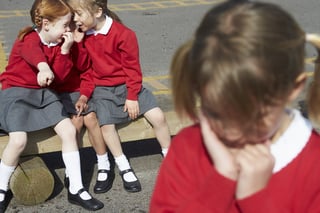 No one wants to hear that their child is acting aggressively toward other children. If your child steps over the line more than once, you may wonder how to tell if he or she is a bully.
No one wants to hear that their child is acting aggressively toward other children. If your child steps over the line more than once, you may wonder how to tell if he or she is a bully.
We talked earlier about the types of bullying. But what is bullying, and how do you know if your child is involved?
According to the U.S. Department of Health and Human Services, bullying is undesired, aggressive behavior among students that involves a real or perceived power imbalance. The behavior is repeated, or has the potential to repeat. Children who bully, and who are bullied, may suffer the consequences throughout life.
Bullying Statistics: Damage by the Numbers
This October marks the tenth annual observance of National Bullying Prevention Month. Bullying statistics show that those who suffer from bullying include those who are victims, those who bully, and those who witness the abuse.
Notes Bridgid Normand, a program developer for the Committee for Children, “It's all about power. Kids who bully others are after dominance. They are often the popular ones, the kids who are throwing their weight around in the schools.”
Some important bullying statistics include:
- About 28 percent of children in grades 6 through 12 report they have experienced bullying.
- About 30 percent of students admit in surveys that they bully other students.
- More than 70 percent of students report they witness bullying of others.
- The most common types of bullying are social and verbal. Physical and cyberbullying occur less frequently.
- Between 20 and 30 percent of children being bullied tell an adult.
Children who are bullied display a higher susceptibility to anxiety and depression throughout life. In addition to poor grades, children who bully are more vulnerable to substance abuse and other social problems. Bullies are also at higher risk throughout adulthood for criminal behavior and substance abuse.
These compelling statistics give parents pause to wonder if their child could be a bully. How would you know?
Here are two profiles to watch for:
- Isolated children with low self-esteem who are less involved in school and prone to peer pressure could be more likely to bully. Oftentimes these children have a lessened sense of empathy, or they may be experiencing abuse or disruption at home. These children may be doing poorly at school, or feel they need to bully in order to avoid being bullied.
- A different type of bully is a student who may be popular, smart, and able to manipulate a social setting in order to remain dominant in the group. These individuals can sometimes be dynamic leaders if they receive the right kind of support to stop bullying.
Know the types of bullying behaviors to watch.
The types of bullying behaviors that could help you recognize whether your child is a bully include:
- At home or at school, does your child have difficulty following rules? Are they inclined to be aggressive at home, school, or elsewhere?
- Does your child have friends who are bullies, or consider violence an effective way to get what they want?
- Is your child too concerned with being popular?
- Are you or the other parent estranged from your child, or are there other issues, such as divorce, impacting your child at home?
- Has your child been bullied by others or abused by adults?
- Does your child often call people names and test boundaries?
- When your child does not get their own way, do they lose control of themselves? Is their attitude hostile? Is your child manipulative, charming and able to talk themselves out of trouble?
No parent wants to believe their child is hurting others or is prone to violence. If you believe your child is a bully, or at risk of becoming a bully, you can take steps to stop the downward spiral of their behavior and the negative impact it has on those around them.
- Engage with your child: Spend more time with your child. Model respectful, compassionate behavior in your home. Know where your child is going and who they are going with. Set behavioral boundaries and maintain them.
- Use consistent discipline: If your child is being abusive at home, there is a good chance they are doing it at school. Stay in touch with teachers. Know the bus driver. Stop and correct your child when they are out of line, and do not wait for someone else to do it for you. Rapid response and consequences are important and help your child understand key life skills such as responsibility and self-control.
- Intervene and get help: Speak with the school, consult a mental health professional, and seek resources, information, and people who can help you, your child, and your family.
Whether your child is bullying or being bullied, recognize the need for help. There is no reason to be ashamed or embarrassed. Intervention is essential to help stop bullying whenever it occurs.




